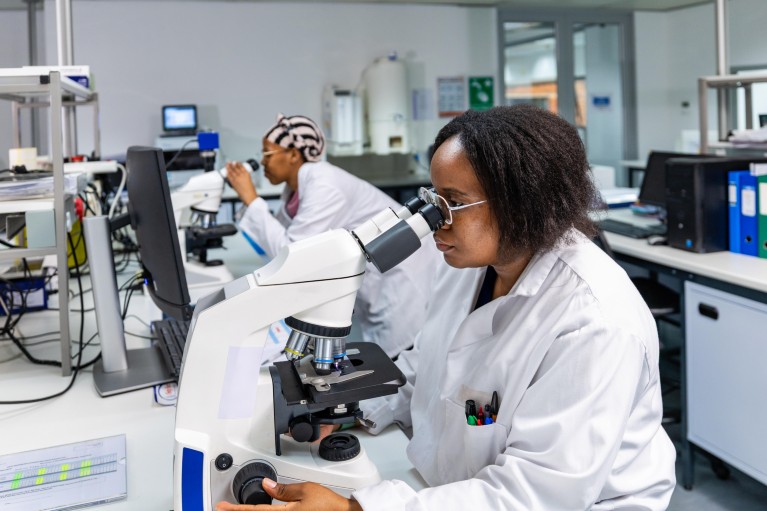
Credit: Getty
Kenya has made science, technology, and innovation central to its national development strategy, with bold plans to transform its economic base through research and higher education. But, while it is a leader in scientific innovation within Africa, its research landscape is under pressure from domestic austerity and dwindling international support.
Despite a legal mandate in the 2013 Science, Technology and Innovation Act to allocate 2% of GDP to research, current public funding lags behind, although it is close to the 1% target set by the African Union in its Agenda 2063.
Key driver
The National Research Fund (NRF), established in 2015, remains the key agency driving the national research agenda. While the bulk of its funding is from the government, around 25% of its funds come from the private sector, donors and investments.
The fund’s CEO, Dickson Andala, says the institution has spent KES 6.1 billion ($US46 million) since its inception to support hundreds of research projects, postgraduate scholars, and innovation initiatives across the country. “In 2023–2024 alone,” he says, “NRF funded 36 research projects and awarded KES 384.9 million ($US 2.9 million) to more than 700 master’s and PhD students. An additional 50 research projects are planned for funding in 2024–2025.”
The most recent data from the Commission for University Education (CUE) shows that in the 2022/2023 academic year, 7,581 PhD students were enrolled across public and private universities in Kenya.
Notable breakthroughs supported by NRF include the development of a topical treatment for tungiasis — a skin disease caused by the sand flea—and genetic improvement of the Sahiwal cattle breed. Beyond funding, the NRF supports research infrastructure, facilitates scientific symposia, and promotes knowledge sharing among institutions and researchers.
International support
Much of Kenya’s R&D funding – about KES 100 billion ($US97 billion) comes from international sources. With foreign funding cuts, including to USAID and related programmes, the role of external donors has become even more crucial. Filling the gap are organisations such as Canada’s International Development Research Centre (IDRC), the French Development Agency (AFD), the British High Commission, and SGCI-Africa, which support institutions like KEMRI, KALRO, and Masinde Muliro University of Science and Technology.
Germany’s DAAD has also played a consistent role in Kenya’s R&D landscape. Since the early 2000s, it has funded 135 postgraduate scholarships and collaborated with KEMRI, KALRO, and several universities through joint research programmes.
African partnerships are increasingly influential. Kenya is one of the main recipients of funding from the African Academy of Sciences (AAS) and the Science Granting Councils Initiative (SGCI) which are providing fellowships and funding in critical areas such as green transitions, innovation and technology, higher education, social sciences, and public health.
“In Kenya, fellowships have been awarded to students from the universities of Nairobi, Jomo Kenyatta, and Egerton,” says Obed Ogega, AAS programmes director.
Andala adds: “These collaborations are enhancing research capacity in strategic sectors such as artificial intelligence, climate science, public health, and indigenous knowledge.” However, he cautions that key challenges remain, including delayed disbursements and infrastructural limitations.
Flagship programmes
The Kenya Medical Research Institute (KEMRI) remains Kenya’s flagship research institute and is the only Kenyan organisation to appear in the top 200 global government research institutions, ranking 168 in the Nature Index, a database that tracks author contributions to research articles published in a set of high-quality natural-science and health-science journals.
KEMRI has had a close collaboration with Japan for decades, primarily facilitated by the Japan International Cooperation Agency (JICA). In July 2025, Japan granted KEMRI KES 3 billion ($US 23 million) for a high-level biosafety facility. The centre, intended to strengthen preparedness for biothreats and future pandemics, will feature state-of-the-art laboratories for pathogen identification, disease surveillance, and the development of diagnostic kits, drugs, and vaccines. The government has called the project a key component of Kenya’s push toward Universal Health Coverage.
Major multinational tech companies are also investing in Kenya to secure access to the East African data market. In mid-2024, the Ministry of Information, Communications and the Digital Economy partnered with Microsoft, and the Emirati AI holding company, G42, and other stakeholders in a $US1 billion investment package. The initiative includes a state-of-the-art green data centre to run Microsoft Azure’s new East Africa Cloud Region. It also establishes an East African Innovation Lab in Nairobi to help local startups, researchers, and institutions build cloud and AI solutions.
